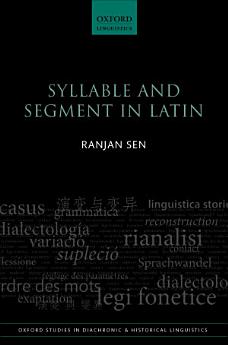Syllable and Segment in Latin
Ranjan Sen
ມ.ນ. 2015 · Oxford Studies in Diachronic and Historical Linguistics ຫົວທີ 16 · OUP Oxford
ປຶ້ມອີບຸກ
352
ໜ້າ
family_home
ມີສິດ
info
reportບໍ່ໄດ້ຢັ້ງຢືນການຈັດອັນດັບ ແລະ ຄຳຕິຊົມ ສຶກສາເພີ່ມເຕີມ
ກ່ຽວກັບປຶ້ມ e-book ນີ້
Syllable and Segment in Latin offers new and detailed analyses of five long-standing problems in Latin historical phonology. In so doing, it clarifies the relative roles of synchronic phonological structure and phonetics in guiding sound change. While the phenomena can predominantly be explained by a reductionist view of diachronic phonology, claiming that demands of speech production and perception alone motivate and constrain historical development, the author shows that synchronic structure played the pivotal role of governing significant (but not immediately apparent) categorical and gradient surface variants, and that some phonetically explicable developments were in fact initiated and constrained by structural analogy. Ranjan Sen considers examines clear and dark /l/; inverse compensatory lengthening; syllabification before stop + liquid in vowel reduction; vocalic epenthesis in stop + /l/; and consonantal assimilations. He ascertains the phonological conditions for each phenomenon, reconstructs the motivations for the changes, and develops a methodology for the appropriate use of evidence from non-current languages to evaluate theories of diachronic phonology. He evaluates the likely phonetic and phonological influences by investigating studies across languages, establishing a secure evidence base through detailed philological examination, and reconstructing the phonetics - through both general principles and pertinent experimental studies - and the relevant phonological structure of the language. The book will appeal to graduate students and researchers in historical linguistics, phonology, Classical philology, and Indo-European linguistics.
ກ່ຽວກັບຜູ້ຂຽນ
Ranjan Sen is a Lecturer in Linguistics in the School of English, University of Sheffield. His main research interest is sound change, focusing particularly on developing techniques to reconstruct and account for phonological change over time, and investigating to what extent synchronic structure plays a role in diachronic phonology. He is the author of 'Reconstructing phonological change: duration and syllable structure in Latin vowel reduction' (Phonology 29, 2012), 'Exon's Law and the Latin syncopes' (in Philomen Probert & Andreas Willi (eds.), Laws and Rules in Indo-European, OUP, 2012), and 'Diachronic phonotactic development in Latin: the work of syllable structure or linear sequence?' (in Charles Cairns & Eric Raimy (eds.), Handbook of the Syllable, Brill, 2011).
ໃຫ້ຄະແນນ e-book ນີ້
ບອກພວກເຮົາວ່າທ່ານຄິດແນວໃດ.
ອ່ານຂໍ້ມູນຂ່າວສານ
ສະມາດໂຟນ ແລະ ແທັບເລັດ
ຕິດຕັ້ງ ແອັບ Google Play Books ສຳລັບ Android ແລະ iPad/iPhone. ມັນຊິ້ງຂໍ້ມູນໂດຍອັດຕະໂນມັດກັບບັນຊີຂອງທ່ານ ແລະ ອະນຸຍາດໃຫ້ທ່ານອ່ານທາງອອນລາຍ ຫຼື ແບບອອບລາຍໄດ້ ບໍ່ວ່າທ່ານຈະຢູ່ໃສ.
ແລັບທັອບ ແລະ ຄອມພິວເຕີ
ທ່ານສາມາດຟັງປຶ້ມສຽງທີ່ຊື້ໃນ Google Play ໂດຍໃຊ້ໂປຣແກຣມທ່ອງເວັບຂອງຄອມພິວເຕີຂອງທ່ານໄດ້.
eReaders ແລະອຸປະກອນອື່ນໆ
ເພື່ອອ່ານໃນອຸປະກອນ e-ink ເຊັ່ນ: Kobo eReader, ທ່ານຈຳເປັນຕ້ອງດາວໂຫຼດໄຟລ໌ ແລະ ໂອນຍ້າຍມັນໄປໃສ່ອຸປະກອນຂອງທ່ານກ່ອນ. ປະຕິບັດຕາມຄຳແນະນຳລະອຽດຂອງ ສູນຊ່ວຍເຫຼືອ ເພື່ອໂອນຍ້າຍໄຟລ໌ໄໃສ່ eReader ທີ່ຮອງຮັບ.







